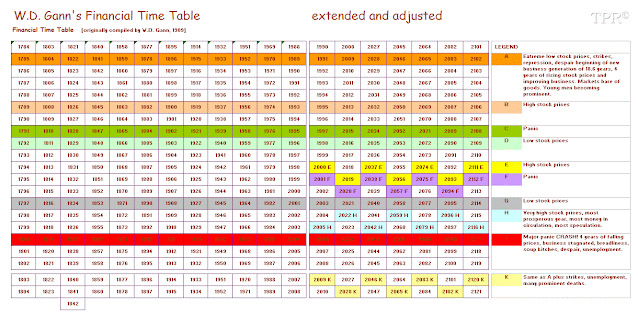A 56-year cycle has been established in trends of US and western European financial crises since 1760 (Funk 1932; McMinn 1996). Clearly, many major financial crises are precipitated by some mechanism, as they tend to occur preferentially in patterns of the 56-year cycle and not as random events. Numerous cosmic factors were examined for some link with the timing of financial crises.
Traditional astrology and sunspots were the initial areas favoured for assessment, but no significance could be realized. This is hardly surprising, as rigorous research has offered little support for astrological theory (Dean and Mather 1978; Culver and Ianna 1984). However, the 56-year cycle was found to correlate very closely with cycles of the sun and moon.
The author believes changing mob psychology forms the basis of cycles of financial crises. This repetitive cycle of speculative frenzy, panic, and pessimism has persisted throughout modern economic history; people learn very little from the greed and foolishness of the preceding generation. People are hypothesized to undergo alterations in mass mood in accordance with changing sun-moon cycles. Financial crises occur when there is a sudden shift in sentiment from optimism to fear.
This paper follows directly on from the work of McMinn (1996). The underscored years are listed as major crises by Kindleberger (1989).
Solunar Cycles: The nodal cycle (or nutation cycle) equals 18.6 years. The north and south nodes are two hypothetical points, 180° apart on the ecliptic circle, where the plane of the earth’s orbit around the sun (the ecliptic) is intersected by the plane of the moon’s orbit around the earth. (The moon’s orbit is inclined at 5° to the ecliptic.) The ascending (north) node is the point where the moon crosses from below to above the ecliptic. The descending (south) node is where the moon crosses from above to below the ecliptic. The moon’s north node takes 18.6 years (one nodal cycle) to complete one cycle retrograde (clockwise) through the ecliptic circle.
The solar year equals 365.24 days. This is the time the sun takes to complete one cycle of the ecliptic circle. This time unit forms the basis of the 56-year sequences, the 36-year subcycles (9, 18, 36, 54 years), and the various artifact subcycles (10/20 years, 13/26/52 years, etc.).
The eclipse year equals 346.62 days. This is the time the sun takes to complete one cycle, north node to north node. For an eclipse to take place, the sun-moon-earth must align in a straight line, which can only happen when the sun and moon are near the north and/or south node. A solar eclipse (partial or total) can occur only when a new moon (i.e., the sun is 0° to the moon) is within about 19° of the nodes. Similarly, a lunar eclipse may only be evident when a full moon (i.e., the sun and moon are 180° apart) is within about 12° of these points.
The saros cycle equals 18.03 years. It has been widely appreciated for millennia and was known to the ancient Babylonian astronomer-priests. Every 223 lunar months (one saros cycle), the sun, moon, and the moon’s nodes align in the same relative angles to each other within a fraction of a degree. One saros cycle of 18 solar years is equal to 19 eclipse years.
The half-saros cycle equals 9 years. Every 9 solar years (or 9.5 eclipse years), the moon’s mean relative position is the same angle to the north node, with the sun 180° on the opposite side of the zodiac.
The 56-year cycle. Every 56 years, the sun conjuncts (0° angle) the moon’s north node in almost the same zodiacal position (3° clockwise) and on the same date (minus three or four days). Every 56 solar years (or 59 eclipse years), the sun’s relative position is approximately the same angle to the north node, with the moon 180° on the opposite side of the zodiac.
A similar alignment of solunar cycles occurs every 56 years (692.5 lunar months), as is evident for the half saros (111.5 lunar months) (see Table 1). The 5 in the latter two figures result in alternating solar/lunar eclipses and full/new moons every 111.5 and 692.5 lunar months, respectively.
These cycles—based on the angles 0° and 180° between the sun, moon, and nodes—repeat to within one degree. This is an astonishing astronomical fluke.




Solar year: one cycle of the sun from spring equinox to spring equinox; equal to 365.2422 days
Eclipse year: one cycle of the sun from north node to north node; equal to 346.6200 days.
Synodic month: interval between two successive new moons; equals 29.5306 days
Tropical month: one 360° cycle of the zodiac (tropical) by the moon; equal to 27.3216 days.
Nodical month: one cycle of the moon from north node to north node; equal to 27.2122 days.
Note: These are average figures. Perturbations exist in the motions of the earth and moon around the sun and deviations from these figures are evident.
These 9- and 56-year solunar cycles would not arise if the radii of either the earth-sun or earth-moon orbits varied a little from their current mean distance. The reasons for the importance of 0°/180° angles in these two cycles is unknown, though it may be related to the fact that the north and south nodes are always 180° apart in zodiacal and aspectual circles.
Perturbations. Most importantly, solunar cycles are expressed in terms of mean periods, with considerable fluctuations around the averages. For example, the zodiacal position of the moon may vary by as much as 8° from its mean position.

































